|
web site
return to top
History of Attalla, Alabama
circa 1955 from an article by George P. Walker, III
Click here to read about Attalla as it was in 1915 in the book titled Attalla, Alabama - Gateway to the Sunny South The book was given to Mayor O’Rear by Mr. Bob McElroy and was originally published between 1915 & 1920. Author & Publisher are unknown.
Attalla’s history actually predates its incorporation as a town. La Fayette visited what is now Attalla in 1825, as a guest of the U. S. government. A French writer, Courter B. Chateaubriand, was also a visitor and wrote a novel on “Atala, an Indian maiden". (1)
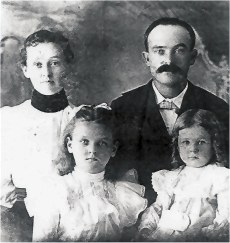 The town occupies the site of an Indian village which was of considerable importance during the Creek War. It was the home of Captain John Brown, a famous Indian, whose daughters, Catharine and Anna, established the Creek Path Mission school in 1820, six miles south of Guntersville. It was in Attalla that David Brown, an Indian, assisted by the Rev. D. S. Butterick, prepared the “Cherokee Spelling Book”. The town occupies the site of an Indian village which was of considerable importance during the Creek War. It was the home of Captain John Brown, a famous Indian, whose daughters, Catharine and Anna, established the Creek Path Mission school in 1820, six miles south of Guntersville. It was in Attalla that David Brown, an Indian, assisted by the Rev. D. S. Butterick, prepared the “Cherokee Spelling Book”.
Early settlers to this area were W. C. Hammond, Henry W. Pickens, Dr. Thomas Edwards, Rev. James Scales, John Latham, E. I. Holcomb, John S. Moragne, and Allen Gray, who became the first postmaster.
Indian relics of the vicinity are “Tsu-sanya-sah --- Ruins-of-a-Great-City”, and the site of the home of Captain John Brown. (2)
Attalla was incorporated as a city government on February 5, 1872, after being founded in 1870 on land donated for the site of the town by W. C. Hammond, a plantation owner. An early business enterprise was a bowling alley in a pine thicket. (3)
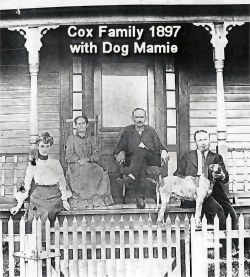 Attalla’s population has remained diminutive in number, but with that small quantity, it has shown dramatic growth throughout the town’s incorporated life. This is illustrated by the following years, population numbers: 1872 - 300; 1888 - 400; 1916 - 4,000; 1940 - 4,585; 1952 - 7,537. (4) Attalla’s population has remained diminutive in number, but with that small quantity, it has shown dramatic growth throughout the town’s incorporated life. This is illustrated by the following years, population numbers: 1872 - 300; 1888 - 400; 1916 - 4,000; 1940 - 4,585; 1952 - 7,537. (4)
In 1832, a Methodist preacher was sent from the Cedar Bluff Circuit to New Town, located eight miles from the east bank of Big Wills Creek, according to records from the Tennessee Conference of the Methodist Church. This location coincides with the present Attalla. In 1840, another Methodist preacher was sent from the Tennessee Conference to Newton.
The name “New Town” was likely changed to “Newton” between 1832 and 1840. Newton was the name Attalla used until February 21, 1870, when “Attalla” was selected as the name for the post office location.
The town was officially named “Attalla” in 1893. (5)
E. I. Holcomb served as the first mayor of Attalla.
There are several opinions as to how the town got the name “Attalla” and what this name actually means. In a rare book on place-names in Alabama, the author states: ”Attalla -- a city in Etowah County. The first settlement here was called Atale, which is a corruption of the Cherokee word ‘otali’, or ‘mountain’.” (6)
“My Home” is the most generally accepted meaning for the name Attalla. Ed Hamner was one of the most erudite men of Attalla in Indian affairs and lore. He served as chairman of the local board of education in Attalla. Regarded as an authority on both ancient and modern history, he was known throughout the area as the leading authority on the Cherokee, Choctaw, and Creek Indians. He also had a small library of rare and expensive books. His claim that Attalla means “ My Home” is accepted by most authorities today. (7)
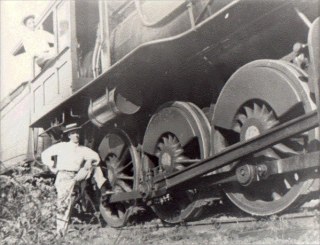 In 1870, Stanton, Cravath, and Stanton, promoters of West Newton, Massachusetts, had completed their Wills Valley Railroad from Chattanooga, TN, along the base of historic Lookout Mountain to its southern extremity, where Attalla is now located. Then they halted operations long enough to build a large hotel and to lay out a town, which they called Newton, in honor of their old home town in Massachusetts. It was there also that the newly chartered road, the Selma, Rome, and Dalton Railroad, came into existence, through the enterprise of the citizens of Gadsden and Guntersville. Thus the railroad crossing became a reality, and a part of the Nashville & Chattanooga Railroad system. Later still, the Alabama Mineral Railroad was merged into the Louisville & Nashville system, and this made Attalla the converging center of these great railroads. The Wills Valley Railroad had become the Alabama Great Southern, and part and parcel of the Southern Railway System. In 1870, Stanton, Cravath, and Stanton, promoters of West Newton, Massachusetts, had completed their Wills Valley Railroad from Chattanooga, TN, along the base of historic Lookout Mountain to its southern extremity, where Attalla is now located. Then they halted operations long enough to build a large hotel and to lay out a town, which they called Newton, in honor of their old home town in Massachusetts. It was there also that the newly chartered road, the Selma, Rome, and Dalton Railroad, came into existence, through the enterprise of the citizens of Gadsden and Guntersville. Thus the railroad crossing became a reality, and a part of the Nashville & Chattanooga Railroad system. Later still, the Alabama Mineral Railroad was merged into the Louisville & Nashville system, and this made Attalla the converging center of these great railroads. The Wills Valley Railroad had become the Alabama Great Southern, and part and parcel of the Southern Railway System.
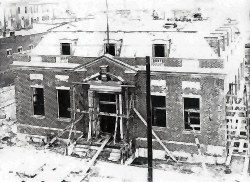 When “Newton,” the town promoted by Stanton, Cravath, and Stanton, grew to sufficient proportions, a post office was requested. There being already a “Newton” post office in the state, they were forced to select another name, and “Attalla” was selected. The name is supposed to have been selected by early French settlers from the name of the heroine, “Atala”, in a popular novel at the time. It should not be over looked, however, that many Cherokee Indians had lived in this section, and that the Cherokees were divided into two classes. Those at home or near their head town were called, Atali,” and those away from home, sometimes classed as hunters, were called “Erati” Cherokees. Thus it will be seen that the word from which the present name, “Attalla”, was derived, is a Cherokee word applied to Indians at home, and is generally accepted as meaning “home” and “my home”. When “Newton,” the town promoted by Stanton, Cravath, and Stanton, grew to sufficient proportions, a post office was requested. There being already a “Newton” post office in the state, they were forced to select another name, and “Attalla” was selected. The name is supposed to have been selected by early French settlers from the name of the heroine, “Atala”, in a popular novel at the time. It should not be over looked, however, that many Cherokee Indians had lived in this section, and that the Cherokees were divided into two classes. Those at home or near their head town were called, Atali,” and those away from home, sometimes classed as hunters, were called “Erati” Cherokees. Thus it will be seen that the word from which the present name, “Attalla”, was derived, is a Cherokee word applied to Indians at home, and is generally accepted as meaning “home” and “my home”.
Miss Ida Hamner believes that the Indian village that used to be where Attalla is now, was called “Otali”, meaning “mountain”, after which Attalla may have been named. Otali was one of the chief Indian villages of the Cherokee nation. Her brother, Ed Hamner, has made note of certain places in the present corporate limits of the town where Indian families definitely lived.
George Guest (Se-Quo-Yah), son of Colonel Nathaniel Guest and his Indian wife, who was a sister of the celebrated “Peace Chief” Ke-a-hat-a-he, as a boy migrated with his mother (the father being listed as one of the casualties of the battle of King’s Mountain in the American Revolution), and settled in Big Wills Valley. But he was no doubt a familiar figure in all of the Cherokee towns in the Valley, as he was a blacksmith, silversmith, and an all-round mechanic before he invented his Cherokee alphabet; and made tomahawks and such other things as his people of the Valley used or needed. He was recognized as the greatest of his race in this part of the country. Congress voted him a largess of $500, and had his picture painted and placed in the government archives at Washington, DC; voted $1,000 to his people with which to buy a printing press, and “Cherokee alphabet” type; and $20,000 for the establishment and maintenance of Indian schools; while the Cherokees themselves, through their council, voted Sequoyah a medal. This occurred shortly after Sequoyah voluntarily migrated to the West, in about 1823. (8)
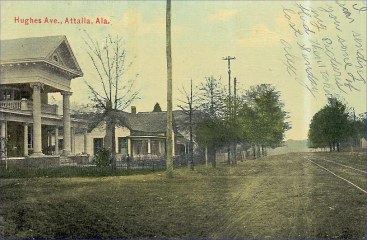 One of the most distinguished men in Attalla’s history was Commodore Ebenezar Farrand. He served in both the United States Navy and the Confederate States Navy. When the Civil War began, Farrand, a staunch believer and supporter of the Confederate cause, left his home, friends, and family and joined the Confederate Navy. When the war ended, he became an insurance representative in Montgomery, Alabama. In 1879, when the Alabama Great Southern Railroad was built through Attalla, and a hotel was built on the railroad property there to serve as a depot and as an eating place, he went to Attalla and became the first one to operate it. This hotel, a replica of the famous Stanton House in Chattanooga, was one of the town’s most outstanding landmarks until it was either burned or dismantled in the 1950’s. When he died in 1873, Farrand was buried in the old Attalla cemetery, which was later abandoned. Mrs. M. E. McKenzie, a friend who knew him as a great gentleman, placed a stone marker at his grave. Later her adopted daughter, the late Mrs. Lalla Rock Foreman, organized the Farrand Chapter of the Daughters of the Confederacy and selected as one of its first projects the placing of an appropriate marker in downtown Attalla (placed at the “Y” where 3rd and 4th Streets merge). It was later removed as a traffic hazard and was placed on the Attalla City School grounds in June of 1947. One of the most distinguished men in Attalla’s history was Commodore Ebenezar Farrand. He served in both the United States Navy and the Confederate States Navy. When the Civil War began, Farrand, a staunch believer and supporter of the Confederate cause, left his home, friends, and family and joined the Confederate Navy. When the war ended, he became an insurance representative in Montgomery, Alabama. In 1879, when the Alabama Great Southern Railroad was built through Attalla, and a hotel was built on the railroad property there to serve as a depot and as an eating place, he went to Attalla and became the first one to operate it. This hotel, a replica of the famous Stanton House in Chattanooga, was one of the town’s most outstanding landmarks until it was either burned or dismantled in the 1950’s. When he died in 1873, Farrand was buried in the old Attalla cemetery, which was later abandoned. Mrs. M. E. McKenzie, a friend who knew him as a great gentleman, placed a stone marker at his grave. Later her adopted daughter, the late Mrs. Lalla Rock Foreman, organized the Farrand Chapter of the Daughters of the Confederacy and selected as one of its first projects the placing of an appropriate marker in downtown Attalla (placed at the “Y” where 3rd and 4th Streets merge). It was later removed as a traffic hazard and was placed on the Attalla City School grounds in June of 1947.
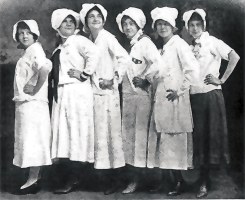 Judge Henry W. Pickens made the first move to establish a school and a church here in 1872, when he purchased the sites and donated them to the town with the condition that the property be used for no other purpose. He was an early postmaster of Attalla, and an officer in the Confederate army. His grave in the old Attalla cemetery remains as one of the few marked graves. (9) Judge Henry W. Pickens made the first move to establish a school and a church here in 1872, when he purchased the sites and donated them to the town with the condition that the property be used for no other purpose. He was an early postmaster of Attalla, and an officer in the Confederate army. His grave in the old Attalla cemetery remains as one of the few marked graves. (9)
In 1889, C. D. Henley, who later became the first mayor of Birmingham, built a brick building. Henley’s building became the bank of Attallla on July 12, 1889, the first bank recognized as such in Attalla, and the second in Etowah County. In 1906, its name was changed to the First National Bank. (10)
 The first church in Attalla, a Presbyterian church, was built in 1851, when the surrounding area was farmland and woodlands. The second church, Northern Methodist (Methodist Epsicopal), was built in 1860, before Attalla was surveyed. The first school was held in that church, and the people sat on half logs with pegs for legs. A Southern Methodist Episcopal church was erected in 1865. In 1887, a Baptist church was organized in the Clements school house by Hamilton Ralls of Gadsden, Mrs. L. E. Harrison, and Mrs. W. S. White. After Attalla incorporated, there were two schools; the Hudson School and the Clements School. The Hudson school was the first and was taught by the Reverend T. E. Hudson. The Clements school, called the Attalla High School, was taught by the Reverend M. K. Clements. Besides teaching at his school, Reverend Clements preached at the Methodist church. The two schools had a keen rivalry between them, and “school butter” was the forsaken word, such as “bell hop” is for certain military schools today to arouse a fighting school spirit. In 1891, the two schools were consolidated across town in the first brick building constructed for a school. This school was taught by E. O. McCord. (11) The first church in Attalla, a Presbyterian church, was built in 1851, when the surrounding area was farmland and woodlands. The second church, Northern Methodist (Methodist Epsicopal), was built in 1860, before Attalla was surveyed. The first school was held in that church, and the people sat on half logs with pegs for legs. A Southern Methodist Episcopal church was erected in 1865. In 1887, a Baptist church was organized in the Clements school house by Hamilton Ralls of Gadsden, Mrs. L. E. Harrison, and Mrs. W. S. White. After Attalla incorporated, there were two schools; the Hudson School and the Clements School. The Hudson school was the first and was taught by the Reverend T. E. Hudson. The Clements school, called the Attalla High School, was taught by the Reverend M. K. Clements. Besides teaching at his school, Reverend Clements preached at the Methodist church. The two schools had a keen rivalry between them, and “school butter” was the forsaken word, such as “bell hop” is for certain military schools today to arouse a fighting school spirit. In 1891, the two schools were consolidated across town in the first brick building constructed for a school. This school was taught by E. O. McCord. (11)
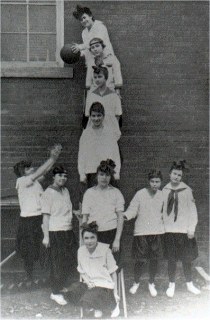 During reconstruction, P. J. Smith was sent south by a northern concern to set up Republican newspapers in towns and cities of the South. He called his newspaper the “Republican Union” and began publication in Attalla on Friday, May 20, 1870. This was the first newspaper ever published in Attalla. It was radical in politics and thus did not survive long. Smith also operated the Attalla Hotel for a short period after the death of Commodore Farrand. (12) During reconstruction, P. J. Smith was sent south by a northern concern to set up Republican newspapers in towns and cities of the South. He called his newspaper the “Republican Union” and began publication in Attalla on Friday, May 20, 1870. This was the first newspaper ever published in Attalla. It was radical in politics and thus did not survive long. Smith also operated the Attalla Hotel for a short period after the death of Commodore Farrand. (12)
“In 1885, the ‘Pick and Shovel’ newspaper was established -- the name being the embodiment of industry -- probably due to the fact that Attalla had become the largest iron ore shipping point in Alabama. When the ‘Pick and Shovel’ gave up the struggle, the ‘Crescent’ became its successor.” (13) Next came the “New Age,” then the Attalla “Herald,” published by G. Thomas Moore, and later J. W. Mills. Attalla’s only newspaper in 1955 was “The Etowah News Journal”.
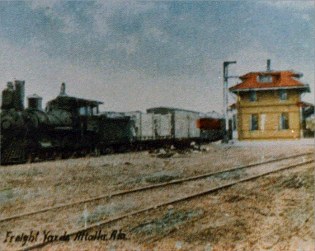 Attalla was prosperous until the railroads, upon which it depended, went into bankruptcy. After that, the town had a precarious existence for almost a decade. The subsequent resuscitation of the railroads did not benefit Attalla, at least for some time, because trade went to other places and through other channels; also some of its most prominent businessmen relocated elsewhere, thus depriving it of a very important auxiliary to progress. The town remained in a stagnant, listless condition until the opening of the iron mines in the surrounding mountains. The development of this new industry, with all its various accompaniments, put life and vigor into the area and started it on a safe and solid road to prosperity. Attalla was prosperous until the railroads, upon which it depended, went into bankruptcy. After that, the town had a precarious existence for almost a decade. The subsequent resuscitation of the railroads did not benefit Attalla, at least for some time, because trade went to other places and through other channels; also some of its most prominent businessmen relocated elsewhere, thus depriving it of a very important auxiliary to progress. The town remained in a stagnant, listless condition until the opening of the iron mines in the surrounding mountains. The development of this new industry, with all its various accompaniments, put life and vigor into the area and started it on a safe and solid road to prosperity.
John S. Moragne bought mineral lands at Attalla in 1859, and sank what was probably the first iron ore shaft in Northeast Alabama. In 1871, he shipped the first carload of iron ore by rail out of the state, to Wheeling, West Virginia. (14) He was perhaps the first person to call attention to the rich coal and iron deposits in North Alabama. “In the 1880’s his collection of minerals, gathered during his wanderings over this part of the state, won the first prize at the state fair. He and John W. Duncan, his son-in-law, hauled the ore from the first Attalla mine to the railroad in wagons. Their mining methods were rather primitive as compared to modern methods. The Moragne estate owned much more land near Attalla. One large section was sold in the 1890’s to a Chattanooga concern for $45,000, but it did not include the operating mines later owned by the Sloss-Sheffield Mining Company.
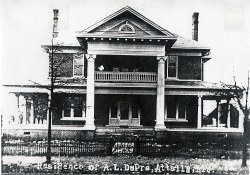 “In the late 1880’s, Attalla was noted as being the largest iron ore shipping point in the state. At first, the ore was hauled from the mines by horse drawn wagon and piled at the corner of Fifth Avenue and the Alabama Great Southern Railroad. It was probably loaded on the train by men wielding shovels, then shipped to furnaces in Chattanooga and Birmingham, and finally taken to Gadsden furnaces.” (15) “In the late 1880’s, Attalla was noted as being the largest iron ore shipping point in the state. At first, the ore was hauled from the mines by horse drawn wagon and piled at the corner of Fifth Avenue and the Alabama Great Southern Railroad. It was probably loaded on the train by men wielding shovels, then shipped to furnaces in Chattanooga and Birmingham, and finally taken to Gadsden furnaces.” (15)
After the wagons became impractical, small dummy trains were used to haul the ore from the mines. Ben Stewart was a conductor on one of these small trains for years. He and Obal Christopher made up the first of Christopher & Stewart which ran the commissary to their mine and cotton gin. Stewart was mayor of Attalla at one time. The Christopher and Stewart store was the first of its kind in Attalla, and was one of the main stores in town. (16)
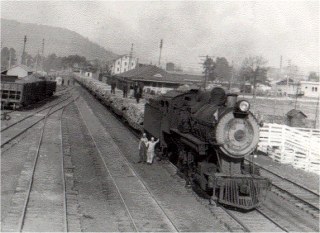 Before Attalla was incorporated, it was called the “Junction.” In 1893, an article appeared in the Attalla “Herald” which said, “Attalla is a city made by the railroads. It grew because it had to grow, and the railroads came because they had to, and will have to come, to get away from the mountains. Its destiny is fixed by its location, and its people are alive to this fact, and the active bustling town is a living example of present prosperity.” (17) Before Attalla was incorporated, it was called the “Junction.” In 1893, an article appeared in the Attalla “Herald” which said, “Attalla is a city made by the railroads. It grew because it had to grow, and the railroads came because they had to, and will have to come, to get away from the mountains. Its destiny is fixed by its location, and its people are alive to this fact, and the active bustling town is a living example of present prosperity.” (17)
The East Alabama & Cincinnati Railroad was constructed through Attalla and went on as far as Gadsden. This was Attalla’s first railroad to Gadsden. Later the T. & C. Railroad went through, and in 1890, the Gadsden-Attalla Dummy Line did also. The first railroad to Birmingham, the L. & N. Railroad, was first built to Attalla and then stopped for awhile. Its first run through to Birmingham was made on May 23, 1905. That first train had its last run on January 30, 1951.
The first electric generator operated by water was built in September 1882, at Appleton, Wisconsin. The first hydro electric plant for lighting a whole town was invented on a stream in Etowah County near Attalla by W. P. Lay in 1887. This invention in Attalla led to the creation of the Southern Company and Alabama Power.
In that same year, Attalla had its first big fire. It was on the northeast side of Fifth Avenue, between Third and Fourth Streets. All the buildings were made of wood, but luckily the fire only burned in one direction. The second big fire, the most disastrous in the history of Attalla, occurred in 1891. Between the times of these fires, brick buildings were being erected throughout the area, affected by the first fire. These were the first brick buildings to be constructed in Attalla. The second fire burned in both directions, and swept through all buildings between Third and Fourth Streets, demolishing all except three small wooden shanties. It was difficult to bring the blaze under control, because the town had no waterworks and had to depend upon a bucket brigade. (18)
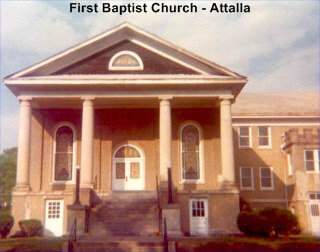 First Baptist Church of Attalla was organized in 1887 under the pastorate of Rev. Henry Edward Harris. He was actually successor to Rev. Hamilton Blount Ralls who was a Baptist Missionary sent to Attalla in 1885, but Rev. Ralls only held meetings in the old Clements School. Rev. Harris was responsible for organizing the church. The stone-constructed sanctuary and buildings shown were the second major facility occupied by the First Baptist Church. The property was obtained on March 17, 1925 and the cornerstone laid on June 7, 1925 as construction began. The first service was held in it on Wednesday, November 11, 1925. The building was demolished in 1980 to make room for a more modern addition to the present main sanctuary which had been built behind this structure in 1960. First Baptist Church of Attalla was organized in 1887 under the pastorate of Rev. Henry Edward Harris. He was actually successor to Rev. Hamilton Blount Ralls who was a Baptist Missionary sent to Attalla in 1885, but Rev. Ralls only held meetings in the old Clements School. Rev. Harris was responsible for organizing the church. The stone-constructed sanctuary and buildings shown were the second major facility occupied by the First Baptist Church. The property was obtained on March 17, 1925 and the cornerstone laid on June 7, 1925 as construction began. The first service was held in it on Wednesday, November 11, 1925. The building was demolished in 1980 to make room for a more modern addition to the present main sanctuary which had been built behind this structure in 1960.
In June, 1891, Attalla awarded a contract to Hartford, Herbert and Company of Chattanooga to build a water works within its limits, and ordered work to begin within 30 days. With this step, Attalla began its career of municipal ownership, and in due time, the city built its own electric and telephone systems. Except for the financial panic that soon started, the venture would have been a success. The telephone and electric systems were sold first, and then the water plant was disposed of to a private concern. One of the conditions of the sale of the water plant was that the new owners would not raise water rates. Within 30 days after the transaction, the company asked the state public utilities commission for permission to advance rates higher. The Supreme Court ruled in favor of the water company. Years later, the City of Attalla purchased the water distribution system, which was all that was left of the original system. It continued the policy of the private concern to purchase water from the Gadsden water plant. (19)
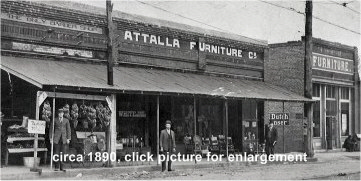 In 1890, the question arose whether to put the county courthouse in Attalla or in Gadsden. A committee of five people convened to discuss and vote on the matter. Commissioners J. B. Washburn and E. A. Gilliland voted to move the county courthouse site to Attalla. Commissioners John W. Miller and Dan G. McCuley voted to retain it in Gadsden. Probate Judge James A. Tallman, the official chairman, broke the tie by voting for Gadsden. It has been said that if Attalla had gotten the courthouse in that vote, the situation of Gadsden’s much greater population growth and Attalla’s growth would have been reversed. In 1890, the question arose whether to put the county courthouse in Attalla or in Gadsden. A committee of five people convened to discuss and vote on the matter. Commissioners J. B. Washburn and E. A. Gilliland voted to move the county courthouse site to Attalla. Commissioners John W. Miller and Dan G. McCuley voted to retain it in Gadsden. Probate Judge James A. Tallman, the official chairman, broke the tie by voting for Gadsden. It has been said that if Attalla had gotten the courthouse in that vote, the situation of Gadsden’s much greater population growth and Attalla’s growth would have been reversed.
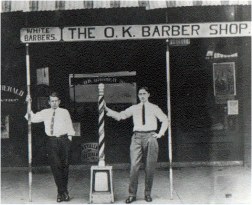 In 1914, a serious effort to consolidate Alabama City and Attalla failed, because the mayor and aldermen of Alabama City balked at the idea at the last moment. J. W. Mills, the clever editor and publisher of the Attalla “Herald” said the plan misfired because of interference by certain Gadsden citizens. The Gadsden papers, however claimed that the city, as a whole, was not interested. “One alderman was the cause of all the trouble,” Mills wrote, “because of misrepresentation by Gadsden people who are telling the Alabama City people that Attalla wants to gobble them up for selfish gain.” He said that Captain J. M. Elliot, Jr. was reported to have told the people of Alabama City that he had no objections to Alabama City “swallowing” Attalla, but he did object to Attalla swallowing” Alabama City. It seems strange, said the “Herald,” “That he (Captain Elliott) should be so all-fired interested when he doesn’t live in either town.” The “Herald” said the officials of the Dwight Manufacturing Company, a large cotton mill which largely made up Alabama City, had favored the merger. In 1914, a serious effort to consolidate Alabama City and Attalla failed, because the mayor and aldermen of Alabama City balked at the idea at the last moment. J. W. Mills, the clever editor and publisher of the Attalla “Herald” said the plan misfired because of interference by certain Gadsden citizens. The Gadsden papers, however claimed that the city, as a whole, was not interested. “One alderman was the cause of all the trouble,” Mills wrote, “because of misrepresentation by Gadsden people who are telling the Alabama City people that Attalla wants to gobble them up for selfish gain.” He said that Captain J. M. Elliot, Jr. was reported to have told the people of Alabama City that he had no objections to Alabama City “swallowing” Attalla, but he did object to Attalla swallowing” Alabama City. It seems strange, said the “Herald,” “That he (Captain Elliott) should be so all-fired interested when he doesn’t live in either town.” The “Herald” said the officials of the Dwight Manufacturing Company, a large cotton mill which largely made up Alabama City, had favored the merger.
The truth was that Captain Elliott founded Alabama City in 1891, and he always wanted the three towns to unite under that name. He wanted to create an industrial center in the area, and did a great deal toward realizing that ambition. Alabama City was his “child” and he never deviated from his campaign for it to absorb both Attalla and Gadsden. In 1931, Alabama City voted by a large majority to merge with Gadsden. (21)
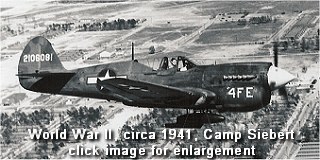 |
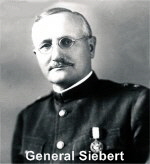 Camp Siebert, primarily in Attalla, was situated in Etowah and St. Clair Counties, Alabama, as a replacement training center for the Chemical Warfare Service by the Department of Defense between 1942 and 1944. The 37,034 acre site was used as a chemical warfare service training center until April 1945. Training included such tasks as smoke screening, chemical decontamination, chemical depot maintenance and chemical impregnation work. During training exercises, fuming sulfuric acid, or FS was dropped on troops from airplanes to simulate an aerial mustard attack. After decontamination, the land was transferred back to private ownership in 1948. The airfield, however, was transferred to the City of Gadsden. Camp Siebert, primarily in Attalla, was situated in Etowah and St. Clair Counties, Alabama, as a replacement training center for the Chemical Warfare Service by the Department of Defense between 1942 and 1944. The 37,034 acre site was used as a chemical warfare service training center until April 1945. Training included such tasks as smoke screening, chemical decontamination, chemical depot maintenance and chemical impregnation work. During training exercises, fuming sulfuric acid, or FS was dropped on troops from airplanes to simulate an aerial mustard attack. After decontamination, the land was transferred back to private ownership in 1948. The airfield, however, was transferred to the City of Gadsden.
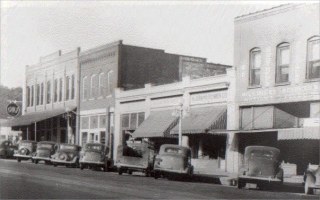 Will I. Martin once said: “Today there is not a more progressive town in Alabama than Attalla. It is a community of fine homes, wonderful people, and a very great promise for the future. It has good government, excellent schools, and enterprising business men. Many of its boosters in the early days lived to prove that they were not far wrong in 1870.” (22) Will I. Martin once said: “Today there is not a more progressive town in Alabama than Attalla. It is a community of fine homes, wonderful people, and a very great promise for the future. It has good government, excellent schools, and enterprising business men. Many of its boosters in the early days lived to prove that they were not far wrong in 1870.” (22)
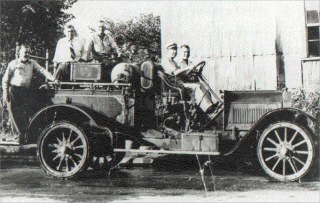 Some of you will remember these nostalgia shots from Attalla’s past. We would love to share your stories and add to the picture collections in the library archives. Call or visit the library to add your content to the living history of Attalla. (23) Some of you will remember these nostalgia shots from Attalla’s past. We would love to share your stories and add to the picture collections in the library archives. Call or visit the library to add your content to the living history of Attalla. (23)
In the image at left, is John D. Hulgan, driving fire truck.
Also person 2nd from left in image is John Ramey
Did you know that Attalla was the first US city to have electric street lights and was also the birthplace of Alabama Power Company? Attalla has been a leader many times during its history. The first web site was installed in Attalla prior to the Internet reaching its present prominence and before being recognized as a basic requirement in the operation of American cities.
* * * * *
FIRST WEB SITE FOR CITY OF ATTALLA
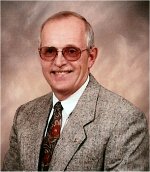 Mayor Charles O’Rear established the first official web site for the City of Attalla in 2001. Under his leadership, the most efficient and effective public communication tool and information distribution medium in history was employed and utilized by the city for over 8 years. Attalla became one of the first small cities in Alabama to go on-line. His vision put Attalla far ahead of most Alabama cities. Mayor Charles O’Rear established the first official web site for the City of Attalla in 2001. Under his leadership, the most efficient and effective public communication tool and information distribution medium in history was employed and utilized by the city for over 8 years. Attalla became one of the first small cities in Alabama to go on-line. His vision put Attalla far ahead of most Alabama cities.
Cost for the web site was donated to the city by the “Bud” O’Rear and Joanna O’Rear family, formerly of Hughes Avenue. www.CityofAttalla.com
Thousands of dollars of taxpayers money was saved monthly by allowing citizens to print out their own event fliers, tax documents, departmental information, city news articles, and to find services directly rather than rely on costly city personnel time, taking them away from providing primary duties in serving their city. Emergency procedures, emergency access notification and real-time weather information saved on police and fire protection expenses.
Major benefit from the web site was achieved by the Recreation Department in support of regional sports teams and large events held in Attalla. The library also distributed free history, research, and photographs to enrich the lives of local citizens. Web site promotion for Trade Days, Heritage Festivals promoted those events to increase local business. Free local business advertising and links to Attalla merchants supported both downtown business and the overall local economy to a global audience.
Charles O’Rear served as the Mayor of Attalla from 2001-2008.
Many Attalla citizens are now asking Charles O’Rear to return to a city leadership role.
These voters are actively supporting honest quality in a mayor's office and for their city.
* * * * *
Footnotes:
This history was edited and somewhat updated for the Internet Portal of the City of Attalla, Alabama, on 02/16/2002 and most content herein was taken from an undated article, “History of Attalla”, by George P. Walker III, likely written between 1955-1958.
1. Jack House, Excerpts from “The Birmingham News, Jan. 8, 1947.
2. Thomas M. Owen, History of Alabama and Dictionary of Alabama Biography S. J. Clarke Publishing Co. , 1921, 1952..
3. 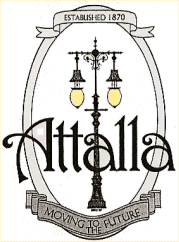 Will I. Martin, Gadsden Times, April 29, 1952. Will I. Martin, Gadsden Times, April 29, 1952.
4. Owen, op. cit., 72
5. Miss Ida Hamner, interview at Attalla, March 21, 1954
6. William A. Reed, Indian Place-Names in Alabama, 6.
7. Martin, Gadsden Times, August 27, 1948
8. Hamner, Gadsden Times, 1929
9. Miss Ida Hamner, interview at Attalla, March 23, 1954, and Martin, Gadsden Times.
10. Miss Ida Hamner, interview March 23, 1954.
11. Miss Hamner, interview, March 23, 1954.
12. Mrs. R. P. Gant, interview, March 19, 1954.
13. Martin, Gadsden Times, April 29, 1952
14. Unlisted
15. Martin, Gadsden Times, January 23, 1953.
16. Miss Hamner, interview, March 14, 1954.
17. June 9, 1893. The Hill Country of Alabama, U.S.A., or the Land of Rest, London and New York.
18. Miss Hamner, interview, March 23, 1954,
and Martin, “If Memory Serves,” compiled by Frances L. Underwood from articles in the Gadsden Times.
19. Martin, Gadsden Times, “If Memory Serves”
20. Partially from Martin, Gadsden Times, August 11, 1947.
21. Martin, Gadsden Times, “If Memory Serves”
22. Martin, Gadsden Times, January 3, 1950.
23. Historic Pictures from Attalla Libary, Scanned by Linda Bowen, Librarian
From A History of Attalla, Alabama circa 1955
return to top
 |
|
We have a “Living History Project”; a way for business and citizen’s families to add to the history of Attalla on the Internet. Help us gather stories.
Click here to submit your entries to the living history of Attalla.
Old pictures are welcomed by email scan.
Your story can be added to the history section on this site.
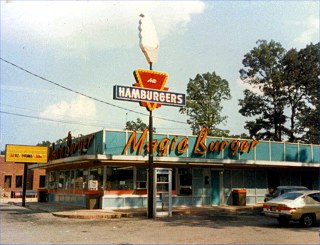 |
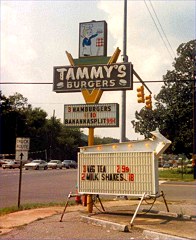 |
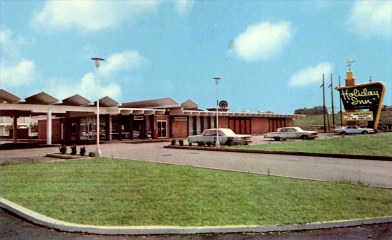 |
This card is special because it shows the old neon and strobe Holiday Inn sign before the company went to a more streamlined look. I loved watching the starburst at the top. My Aunt Sue and her children lived behind the Holiday Inn in the trailer park when my Uncle Jack was in Vietnam. My cousin Mike was born nearly blind and after several corrective surgeries at Maxwell AFB, could only see shapes and lights (with very thick glasses) for several months until his eyes settled down from the surgery. The story goes that Aunt Sue would put Mike in his high chair in the kitchen and open the curtains at night so he could see the flashing star on top of the Holiday Inn sign. He would remain very calm and quiet except for an occasional wave of his hand while he would say "Hello purp-purp!" ... He later told Aunt Sue that the star reminded him of the glass dome in the lid of the "purpalator" (coffee percalator). photo card scan and comments from Mark du Pont
This place above is also still standing and is in quite remarkable shape considering the age of the buildings. The brick house looks much the same now as it did then. The postmark on the card was from 1955 and was actually mailed from Daytona Beach, Florida to Pennsylvania. photo card scan and comments from Mark du Pont
This place is still standing in Attalla and is known as the Sunset Inn now. Postmark on the back is from 1953 and was mailed from Attalla to Piscataway, New Jersey. photo card scan and comments from Mark du Pont
Browns Lake near the Attalla AG&S Depot. I'm not really sure where this lake was unless it's where the viaduct is now. That would make sense as there is a natural spring just under the lowest point of the viaduct. photo card scan and comments from Mark du Pont
Old Union Station - Attalla, photo card scans and comments from Mark du Pont
|
|
 |
click here to get your own real business web site
return to top
|
|